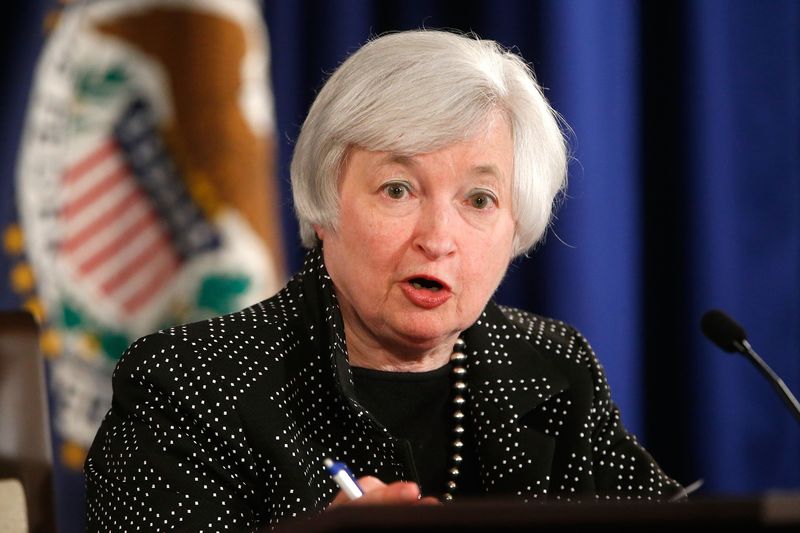Investing.com - Markets hope to gauge Federal Reserve (Fed) chair Janet Yellen’s outlook on the future path of monetary policy in her two-day testimony to Congress beginning on Tuesday, following a generally more hawkish stance shown by other U.S. central bank officials even as several recognized the uncertainty that surrounding the implementation of new fiscal policies.
In her semi-annual monetary policy testimony, Yellen will appear before the Senate Banking Committee at 10:00AM ET (15:00GMT) Tuesday and will deliver the same speech to the House Financial Services Committee at the same time the following day. In both appearances, the Fed chair will respond to questions from the committee members.
Markets will be paying close attention to hints from the Fed chief about her current outlook for the future path of monetary policy, with a particular focus on any hints regarding the timing of the next rate hike.
In December, the U.S. central bank projected three rate increases this year, though markets have remained skeptical, pricing in only two moves in 2017.
With the January inflation figures not to be released until Wednesday, the last major data release was the employment report for the first month of the year, showing the whopping creation of 227,000 jobs.
Perhaps keeping the Fed on hold, the jobless rate unexpectedly rose to 4.8% and wage inflation remained weak.
Officials more hawkish though fiscal policy remains uncertain
Since that report, several Fed officials have chimed in with their own point of view. Philadelphia Fed president Patrick Harker, perhaps the most hawkish of the voting members this year, said he still supported three hikes this year.
“I think March should be considered as a potential for another 25-basis point increase,” he said last week.
The Chicago Fed chief Charles Evans appeared to turn slightly more hawkish as he admitted last Thursday that three rate hikes this year would not be “unreasonable”.
At the beginning of this year, Evans had only had two hikes penciled in but he suggested last week that economic stimulus from President Donald Trump’s future fiscal policies appeared to have only upside risk.
Along the same lines, San Francisco Fed president John Williams pointed out in an interview with Bloomberg that three rate hikes was a “reasonable guess”, but added that the economy’s potential could give more of a boost than what had been expected at the time of the last meeting.
Williams suggested that risk management would dictate a preference for moving sooner, rather than waiting, and said that the possibility of a rate hike in March should remain on the table.
One of the more dovish members, Minneapolis Fed president Neel Kashkari said that the U.S. economy was not yet at full employment and argued for keeping monetary policy accommodative.
“If we are to err, it is better to err on the side of being more accommodative than being more restrictive," he said.
Kashkari also indicated that he had yet to include the possible impact from fiscal policies in his own economic forecasts.
However, St. Louis Fed chief James Bullard kept his own ultra-dovish call for just one rate hike this year and downplayed the possibility that it could happen as soon as March.
Referring to speculation over new Trump administration policies, Bullard indicated that “it is unlikely that fiscal uncertainty will be meaningfully resolved by the March meeting."
While not commenting directly on the number of rate hikes this year, Fed vice chairman Stanley Fischer too showed caution on what impact fiscal policies would have.
“"There is quite significant uncertainty about what's actually going to happen, I don't think anyone quite knows,” he said in response to a question at the Warwick Economics Summit last Saturday.
“It's a process which involves both the administration and the Congress in deciding fiscal policy," Fischer explained.
Yellen may give clues in questions from Congress
The remarks from other Fed officials set the background for Yellen’s own comments in her congressional testimony.
Brown Brothers Harriman strategists noted that little had changed with respect to the economy since the Fed’s last statement in December, suggesting there will be few surprises to Yellen’s testimony.
These experts do believe that Yellen could be questioned about the impact of fiscal policy on interest rates.
“However, while there is little doubt that Fed officials are monitoring the progress of the tax proposals in the negotiating process, it still does not reach the threshold of a policy variable yet,” they explained.
“It may before the mid-March meeting when forecasts will be updated,” these analysts added.
Ahead of Yellen’s appearance, Fed fund futures are currently pricing in around a 13% chance of a rate hike in March, according to Investing.com's Fed Rate Monitor Tool.
Odds for the first rate hike do not pass the 50% threshold until the June meeting, with the probability of the second and final tightening this year at about 70% for a move in December.
Experts coincided more with market predictions according to a survey taken by Reuters just after the publication of the jobs report.
All 14 respondents predicted the Fed would leave rates unchanged at its next meeting in mid-March, and 12 of the 14 forecast policy makers would lift the range by 25 basis points to between 0.75% and 1.00% by the end of the second quarter.
Furthermore, 12 respondents forecast the fed funds target range rising above 1% by year end, with 10 predicting an end-of-year range of 1.00% to 1.25% and two others seeing it increase to as high as 1.25% to 1.50%.
Only one respondent, Mizuho, saw the Fed raising rates only once this year and holding off thereafter until 2018.
